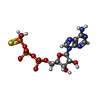+Search query
-Structure paper
| Title | Seesaw conformations of Npl4 in the human p97 complex and the inhibitory mechanism of a disulfiram derivative. |
|---|---|
| Journal, issue, pages | Nat Commun, Vol. 12, Issue 1, Page 121, Year 2021 |
| Publish date | Jan 5, 2021 |
 Authors Authors | Man Pan / Qingyun Zheng / Yuanyuan Yu / Huasong Ai / Yuan Xie / Xin Zeng / Chu Wang / Lei Liu / Minglei Zhao /   |
| PubMed Abstract | p97, also known as valosin-containing protein (VCP) or Cdc48, plays a central role in cellular protein homeostasis. Human p97 mutations are associated with several neurodegenerative diseases. ...p97, also known as valosin-containing protein (VCP) or Cdc48, plays a central role in cellular protein homeostasis. Human p97 mutations are associated with several neurodegenerative diseases. Targeting p97 and its cofactors is a strategy for cancer drug development. Despite significant structural insights into the fungal homolog Cdc48, little is known about how human p97 interacts with its cofactors. Recently, the anti-alcohol abuse drug disulfiram was found to target cancer through Npl4, a cofactor of p97, but the molecular mechanism remains elusive. Here, using single-particle cryo-electron microscopy (cryo-EM), we uncovered three Npl4 conformational states in complex with human p97 before ATP hydrolysis. The motion of Npl4 results from its zinc finger motifs interacting with the N domain of p97, which is essential for the unfolding activity of p97. In vitro and cell-based assays showed that the disulfiram derivative bis-(diethyldithiocarbamate)-copper (CuET) can bypass the copper transporter system and inhibit the function of p97 in the cytoplasm by releasing cupric ions under oxidative conditions, which disrupt the zinc finger motifs of Npl4, locking the essential conformational switch of the complex. |
 External links External links |  Nat Commun / Nat Commun /  PubMed:33402676 / PubMed:33402676 /  PubMed Central PubMed Central |
| Methods | EM (single particle) |
| Resolution | 2.89 - 4.5 Å |
| Structure data |  EMDB-21824:  EMDB-21825:  EMDB-21826:  EMDB-21827:  EMDB-21828:  EMDB-21829:  EMDB-21830: EMDB-22521: Map of human p97 in complex with ATPgammaS and Npl4/Ufd1 (masked around p97 and C6 averaged) |
| Chemicals |  ChemComp-MG:  ChemComp-AGS: |
| Source |
|
 Keywords Keywords | TRANSLOCASE / AAA+ ATPase Chaperon Protein homeostasis |
 Movie
Movie Controller
Controller Structure viewers
Structure viewers About Yorodumi Papers
About Yorodumi Papers





 homo sapiens (human)
homo sapiens (human)